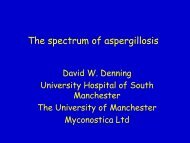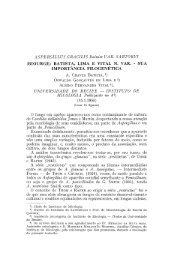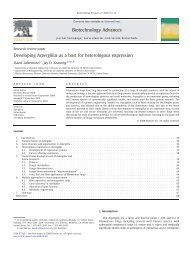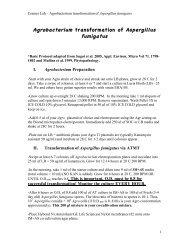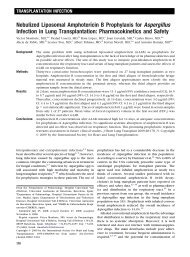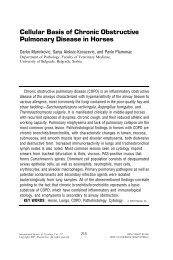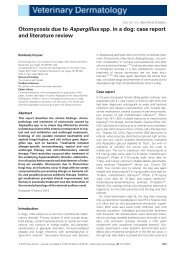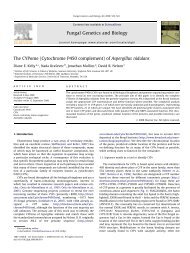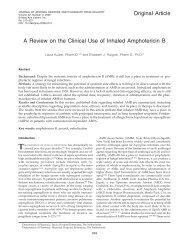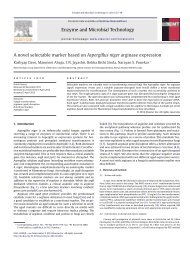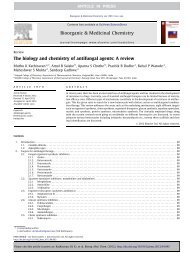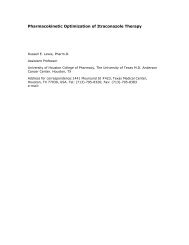Amphotericin B versus amphotericin B plus 5-flucytosine: Poor ...
Amphotericin B versus amphotericin B plus 5-flucytosine: Poor ...
Amphotericin B versus amphotericin B plus 5-flucytosine: Poor ...
Create successful ePaper yourself
Turn your PDF publications into a flip-book with our unique Google optimized e-Paper software.
Originalia<br />
P. E. Verweij, J. P. Donnelly, B. J. Kullberg, J. F. G. M. Meis, B. E. De Pauw<br />
<strong>Amphotericin</strong> B <strong>versus</strong> <strong>Amphotericin</strong> B <strong>plus</strong> 5-Flucytosine: <strong>Poor</strong> Results in<br />
the Treatment of Proven Systemic Mycoses in Neutropenic Patients<br />
Introduction<br />
Summary: Twenty-eight neutropenic (< 500 granulocytes/gl) adults with microbiologically<br />
or histologically proven systemic mycosis were randomly assigned to receive either ampho-<br />
tericin B alone (0.5 mg/kg/day; n = 14) or <strong>amphotericin</strong> B (0.5 mg/kg/day) <strong>plus</strong> 5-<strong>flucytosine</strong><br />
(150 mg/kg/day; n = 14) intravenously. Therapy was given for an average duration of 10 days<br />
in both groups, amounting to a total dose of <strong>amphotericin</strong> B of 338 mg and 308 mg, respec-<br />
tively. The mean duration of granulocytopenia was 18 days in the <strong>amphotericin</strong> B group and<br />
20 days in the combination group. Only two patients treated with <strong>amphotericin</strong> B alone and<br />
three given the combination survived. Adverse events were similiar in both groups with an<br />
elevation of the serum creatinine in six cases during the administration of <strong>amphotericin</strong> B<br />
alone and in seven cases treated with the combination. No other serious adverse events were<br />
encountered. Treatment with both regimens was disappointing partly because mycosis was<br />
too far advanced by the time therapy was begun and neutrophils were recovered in only half<br />
the patients.<br />
Since the introduction of modern broad-spectrum antibac-<br />
terial compounds, which has substantially reduced the mor-<br />
tality due to bacterial infections, fungal infections have<br />
emerged as a major cause of morbidity and mortality in<br />
neutropenic patients [1-4]. The incidence of these infec-<br />
tions has also increased in association with the use of more<br />
aggressive chemotherapy and intravascular devices [5].<br />
Candida and Aspergillus species are the predominant fun-<br />
gal pathogens in acute leukemia [6], but these infections are<br />
difficult to diagnose [7] due to the absence of the classic<br />
inflammatory response and low rate of antibody formation<br />
in these patients. Unfortunately, adequate culturing is ham-<br />
pered by the low specificity of specimens such as sputum<br />
[8-10] and by the need for invasive diagnostic procedures<br />
that may be dangerous because of concomitant thrombo-<br />
cytopenia. Atypical pulmonary infiltrates, as well as unex-<br />
plained disturbances of liver and kidney function and echo-<br />
graphic lesions in these organs may be suggestive of the<br />
diagnosis [11, 12], but these symptoms are certainly not<br />
specific. Consequently, treatment is often commenced on<br />
an empiric basis, most frequently because of fever not re-<br />
sponding to adequate antibacterial therapy [13-15]. More-<br />
over, therapeutic options are qualitatively and quantita-<br />
tively limited. Only three classes of compounds with recog-<br />
nized systemic activity are available: <strong>amphotericin</strong> B, 5-flu-<br />
cytosine, and, more recently, the azoles. Intravenous am-<br />
photericin B, at a dose of 0.5 mg/kg/day, is considered the<br />
standard therapy for granulocytopenic patients suspected to<br />
have a pulmonary or systemic mycosis. The drug is poten-<br />
tially toxic to the liver and kidney [16], causes hypokale-<br />
mia, and many patients show an immediate reaction to its<br />
administration, which may require co-medication with<br />
agents such as pethidine and/or corticosteroids to amelio-<br />
rate the symptoms. These reactions appear to be dose de-<br />
pendent. 5-<strong>flucytosine</strong>, an analogue of cytosine, at a dose of<br />
150 mg/kg/day is effective against Candida and Crypto-<br />
coccus infections, but the fungi may become rapidly resist-<br />
ant if the drug is given alone. Potentially dangerous side<br />
effects of 5-<strong>flucytosine</strong>, particularly bone marrow sup-<br />
pression and liver function impairment, may occur [17].<br />
The concentration in the serum should not fall below<br />
20-25 rag/1 and not exceed 100-120 rag/1. There are data to<br />
suggest that <strong>amphotericin</strong> B and 5-<strong>flucytosine</strong> show<br />
synergistic activity, notably in the treatment of cryptococ-<br />
cal meningitis in AIDS patients [18, 19]. However, definite<br />
evidence on the potential of this therapeutic approach in the<br />
granulocytopenic patient with candidiasis is lacking, al-<br />
though a small series does suggest that combination therapy<br />
may be of benefit, particularly in infections caused by Can-<br />
dida tropicalis [20, 21].<br />
The diagnostic shortcomings do not only hamper the estab-<br />
lishment of an early diagnosis, they also restrict the possi-<br />
bilities of evaluation of therapeutic interventions, since<br />
trials commonly include patients in whom the diagnosis of<br />
Received: 11 November 1993/Revision accepted: 6 February 1994<br />
P. E. Verweij, M. D., J. F. G. M. Meis, M. D., Ph. D., Dept. of Medical<br />
Microbiology, J. P. Donnelly, Ph. D., Prof. B. E. De Pauw, M. D., Ph.D.,<br />
Dept. of Hematology~ B.J. Kullberg, M.D., Ph.D., Dept. of General<br />
Internal Medicine, University Hospital St. Radboud, P.O. Box 9101,<br />
NL-6500 HB Nijmegen, The Netherlands.<br />
Correspondence to: Prof. B. E. De Pauw.<br />
Infection 22 (1994) No. 2 © MMV Medizin Verlag GmbH Mtinchen, Mtinchen 1994 81/21
P, E. Verweij et al.: <strong>Amphotericin</strong> B with or without 5-Flucytosine in Neutropenic Patients<br />
fungal infection is only presumptive. Therefore a trial was<br />
designed to assess the efficacy and safety of amphoteri-<br />
cin B alone in comparison to <strong>amphotericin</strong> B in combina-<br />
tion with 5-<strong>flucytosine</strong> in febrile neutropenic patiens with a<br />
histologically or microbiologicaUy documented systemic<br />
fungal infection. It must be emphasized, however, that in<br />
general it is not our policy to await confirmation of the<br />
diagnosis before starting antifungal therapy; in the majority<br />
of cases systemically active antifungal therapy is started on<br />
an eml~iric basis, but in a subset of patients the diagnosis of<br />
systemic mycosis may become established before suspicion<br />
occurs. It is this category of patients who were the subjects<br />
of the present study.<br />
Patients and Methods<br />
Patients: The protocol was approved by the local medical ethical<br />
committee (number CEOM 1988-001647). Patients over 15 years<br />
of age with a granulocyte count of < 500 cells/gl, that was ex-<br />
pected to last for 10 days or more, due to chemotherapy for acute<br />
leukemia, who were suffering from a proven systemic fungal<br />
infection, were-eligible for this study if they had an estimated<br />
creatinine clearance of > 80 ml/min. All patients were nursed in<br />
protective isolation and had been treated for febrile episodes with<br />
broad spectrum antibacterials, consisting of either ceftazidime or<br />
meropenem as single agents or a Combination of piperacillin and<br />
tobramycin. In the majority of cases the patients had also received<br />
a course of teicoplanin for presumed or proven infections by<br />
resistant gram-positive organisms. Antibacterial treatment was<br />
supplemented by the prophylactic use of oral <strong>amphotericin</strong> B<br />
(500 mg q 6 h).<br />
Fungal infection was considered to be proven if fungi were cul-<br />
tured from deep tissues or normally sterile body fluids or if they<br />
were identified by histological examination of biopsy specimens.<br />
In case of candidemia at least two blood cultures taken from<br />
different veins had to be positive with the same species. Typical<br />
infiltrations on a chest X-ray, in combination with filamentous<br />
fungi (e.g. Aspergillus) in the sputum or assisted sputum produc-<br />
tion (NaC1 0.9% aerosol) specimens with >_ 50 CFU/ml of an<br />
undiluted sample, were regarded as definite evidence for the ex-<br />
istence of pulmonary fungal infection. The results of the cultures<br />
from sputum and bronchoalveolar lavage specimens were com-<br />
pared with the outcome of cultures from a simultaneously taken<br />
oral gargle in order to exclude contamination. Patients with unex-<br />
plained fever not responding to antibacterial therapy were ex-<br />
cluded, as were patients with a presumed fungal infection, i.e.<br />
those with a clinical site of infection without known bacterial or<br />
viral origin.<br />
Patients were examined daily, full hematological profiles were<br />
determined daily and tests of'liver and kidney function, and serum<br />
levels of 5-<strong>flucytosine</strong> were conducted at least twice weekly.<br />
Chest X-rays, echography of the liver, fundoscopy, and invasive<br />
diagnostic procedures, such as bronchoalveolar lavage, were per-<br />
formed on a case-by-case basis.<br />
Procedure: After giving informed consent the patients were ran-<br />
domized to receive either <strong>amphotericin</strong> B alone or amphoteri-<br />
cin B in combination with 5-<strong>flucytosine</strong>. After a test dose of<br />
1 mg, the dose of <strong>amphotericin</strong> B was rapidly increased to 0.5-<br />
1 mg/kg/day intravenously as a 4 h infusion, depending on the<br />
serum creatinine; 5-<strong>flucytosine</strong> was given intravenously as a 30<br />
min infusion in a dose of 150 mg&g/day in four divided doses.<br />
During systemic antifungal therapy, the oral antifungal prophy-<br />
Table 1: Demography and results of therapy.<br />
Number 14 14<br />
Age. (years)<br />
Mean 41.2 42.1<br />
Range 20~6 18-67<br />
Male:female 8:6 9:5<br />
Acute myeloid leukemia 10 8<br />
Acute lymphoblastic<br />
leukemia 4 6<br />
Minimum duration ot~<br />
granulocytopenia before<br />
starting therapy (days) 10 12<br />
Survival/number infected<br />
Pulmonary aspergillosis 1/9 2/9<br />
Hepatic candidosis 0/2 0/2<br />
Candidemia* 1/3 1/3<br />
Overall survival 2/14 3/14<br />
Granulocytes < 100 cells/gl<br />
at the start of treatment 11 12<br />
Mean total dose of<br />
<strong>amphotericin</strong> B (mg) 338 308<br />
* the survivor in each treatment group had catheter-related sepsis due to<br />
Candida parapsilosis and had had the Hickman catheter removed.<br />
laxis was discontinued, while antibacterial coverage was provided<br />
by administering either ceftazidime intravenously or a combina-<br />
tion of colistin and co-trimoxazole orally.<br />
A patient was considered to have responded to therapy when<br />
there was a marked decrease in the size of the initial radiological<br />
abnormalities or when all signs and symptoms of infection had<br />
disappeared. If the fungal infection persisted or progressed, or if<br />
the patient died as a result of this infection, therapy was deemed a<br />
failure. Renal toxicity was defined as an increase.in serum crea-<br />
tinine of more than 30%, and hepatic toxicity as a threefold in-<br />
crease of baseline liver function tests.<br />
Results<br />
Between May 1988 and December 1991 28 patients were<br />
enrolled in this study. The characteristics of the patients are<br />
given in Table 1, showing that the study groups were well<br />
balanced with respect to age, sex, underlying disease, de-<br />
gree of granulocytopenia, and causative fungal organisms.<br />
All candidemias were encountered in patients with central<br />
venous lines in situ. In four patients in the <strong>amphotericin</strong> B<br />
group and six patients in the combination group the diag-<br />
nosis of systemic mycosis was made after fever had persist-<br />
ed for more than 8 days in spite of broad spectrum antibac-<br />
terial therapy, whereas all other patients had initially re-<br />
sponded to these antibiotids but had then developed a sec-<br />
ond febrile episode.<br />
The results, which are also shown in Table 1, were very<br />
disappointing in both groups with a mortality rate of 86%<br />
for <strong>amphotericin</strong> B alone and 79% for the combination, the<br />
22/82 Infection 22 (1994) No. 2 © MMV Medizin Verlag GmbH Mtinchen, Mtinchen 1994
difference being one patient surviving pneumonia caused<br />
by Aspergillusfumigatus in the latter group. Only the two<br />
patients with a Candida parapsilosis infection recovered<br />
even though the central venous line was removed in all<br />
cases with candidemia. Two patients with Candida tropi-<br />
calis sepsis died within 3 days in spite of treatment with<br />
both <strong>amphotericin</strong> B and 5-<strong>flucytosine</strong>. Chronic dissemi-<br />
nated candidosis proved fatal in all four cases, as did 15 out<br />
of 18 (83%) episodes of pulmonary aspergillosis with pa-<br />
tients dying between day 5 and 14 of therapy. The diagnosis<br />
of aspergillosis was confirmed in all eight patients who<br />
underwent autopsy after treatment with <strong>amphotericin</strong> B.<br />
Autopsy was performed in seven patients who had been<br />
treated with the combination; A. fumigatus was found in the<br />
lungs of four and Candida in the liver and all major organs<br />
in one case, while in one other patient there was evidence of<br />
generalized aspergillosis together with candidosis. Granu-<br />
locytopenia had been present on average for 18 days in the<br />
<strong>amphotericin</strong> B group and 20 days in the combination<br />
g_roup, and 16 patients (48%) were still profoundly granulo-<br />
cytopenic with fewer than 100 cells/~tl when they died.<br />
Granulocytes recovered in the three patients who survived<br />
an A. fumigatus pneumonia, whilst the two patients suffer-<br />
ing from C. parapsilosis candidemia were still granulocy-<br />
topenic at the moment of restionse.<br />
The average duration of therapy was 10 days in both<br />
groups, accounting for a total dose of <strong>amphotericin</strong> B of<br />
338 and 308 mg, respectively. All trough serum levels of<br />
5-<strong>flucytosine</strong> were between 20 and 30 rag/l, whereas the<br />
peak values did not exceed 120 mg/1. Only 53% of patients<br />
tolerated a dose of more than 0.5 mg/kg/day amphoteri-<br />
cin B. Elevation of the serum creatinine was seen in six<br />
patients treated with <strong>amphotericin</strong> B alone and in seven of<br />
those treated with the combination, whereas all patients<br />
required suppletion with potassium. No abnormalities in<br />
liver function or bone marrow toxicity, attributable to the<br />
study drugs, were observed.<br />
Discussion<br />
The results of this study were singularly disappointing and<br />
this observation was one of the reasons that led to the early<br />
termination of the study. Neither treatment afforded an ac-<br />
ceptable outcome since only five patients survived. This<br />
may have been due to inadequate dosing with amphoteri-<br />
cin B since 1 mg/kg is now regarded as the optimal dose.<br />
However, the dose is largely determined by patient toler-<br />
ance and any side effects that oCcur require adjusting the<br />
dose downwards and concomitant symptomatic treatment.<br />
It was expected that the addition of 5-<strong>flucytosine</strong> might<br />
have compensated for any deficiency in the dose of ampho-<br />
tericin B by providing a degree of synergism especially<br />
where Candida was concerned [18, 20]. Clearly, this was<br />
not the case and even had it been so, infection had almost<br />
certainly progressed to such an advanced state that any<br />
treatment would have failed. In fact, the single most im-<br />
portant reason for the poor survival rate was probably the<br />
delay caused by requiting the infection to be proven before<br />
P. E. Verweij et al.: <strong>Amphotericin</strong> B with or without 5-Flucytosine in Neutropenic Patients<br />
allowing the patient to enter, as was noted in earlier re-<br />
ports [22-27]. In view of the low number of patients en-<br />
tered and the strict criterium of proven systemic infection<br />
no definite conclusion can be drawn about the possible<br />
superiority of the combination of <strong>amphotericin</strong> B and 5-flu-<br />
cytosine over <strong>amphotericin</strong> B alone. Although the data are<br />
discouraging, the combination might prove beneficial in an<br />
empiric setting or when the diagnosis can be made at an<br />
early stage of the infection, which makes a prolonged<br />
course of antifungal therapy possible [20]. The failure to<br />
recover granulocytes was also a poor prognostic factor [28]<br />
and perhaps indicates a potential role for hematopoietic<br />
growth factors. It was also noteworthy that all patients had<br />
either a new fever or one that had persisted for more than 8<br />
days despite broad spectrum antibiotics. The latter group<br />
should have been candidates for the current practice of<br />
early empiric therapy with <strong>amphotericin</strong> B and might ac-<br />
tually have survived [14, 15]. A second reason to stop the<br />
trial was the fact that promising agents like fluconazole<br />
[29] and liposomal <strong>amphotericin</strong> B [30] became available<br />
for clinical use and therefore the continuation of the study<br />
could no longer be ethically sustained.<br />
The majority of patients had complied with the relatively<br />
high dose of 2 g oral <strong>amphotericin</strong> B as prophylaxis, yet<br />
still succumbed to infection. This was not surprising for<br />
those who developed aspergillosis since the polyene is<br />
not absorbed and would therefore not have had any effect<br />
in the lung. However, oral polyenes were shown by the<br />
EORTC Antimicrobial Cooperative Group to be an im-<br />
portant negative prognostic factor per se, rather than af-<br />
fording any protection against systemic mycosis [14].<br />
Moreover, prophylaxis with polyenes given orally has<br />
never been shown to be effective in a randomized,<br />
placebo controlled setting, not even for Candida. At the<br />
time of this study, we gave prophylaxis with oral ampho-<br />
tericin B the benefit of the doubt since there was no<br />
alternative.<br />
In fact, the results obtained in the present study are simi-<br />
lar to those reported in previous studies [22-28, 3!] if<br />
only histologically or microbiologically documented<br />
cases are taken into account, indicating that the study<br />
group was representative of a poor risk population com-<br />
promised further by prolonged and profound granulocy-<br />
topenia. Hence, the problem of diagnosing infection<br />
early [7] poses as big a dilemma as when to begin ther-<br />
apy. Too long a delay while awaiting laboratory confir-<br />
mation will result in too high a failure rate, while starting<br />
too early on the grounds of persistent fever will lead to<br />
over-treatment. In trying to resolve this problem, one<br />
must consider the epidemiology of fungal infections, the<br />
diagnostic tools that are readily available such as chest<br />
roentgenogram, the value of surveillance cultures as well<br />
as the newer techniques of antigen and nucleic acid de-<br />
tection. Candida infection is endogenous and appears to<br />
occur only in those patients who are colonised. The gas-<br />
trointestinal tract is the commonest reservoir and there-<br />
fore the most likely portal of entry into the bloodstream.<br />
Infection 22 (1994) No. 2 © MMV Medizin Verlag GmbH Mtinchen, Mtinchen 1994 83/23
P. E. Verweij et al.: <strong>Amphotericin</strong> B with or without 5-Flucytosine in Neutropenic Patients<br />
Dissemination is facilitated by the ulceration and damage to<br />
the epithelium that results from chemotherapy and possibly<br />
coexistent infection with herpes simplex. Yeasts may also<br />
gain direct access to the bloodstream via indwelling vascu-<br />
lar catheters.<br />
Aspergillosis presents an entirely different problem because<br />
it is mainly confined to the lungs, at least in the early stages<br />
when the organism is difficult to detect. Infection is usually<br />
associated with clinical and roentgenologic findings sug-<br />
gestive of the diagnosis such as focal infiltrates on a chest<br />
roentgenogram, although disseminated infection occurs in<br />
about 20% of the cases. Since these organisms have a pro-<br />
pensity for invading the blood vessels and causing throm-<br />
bosis, organ infarction is frequently a prominent manifesta-<br />
tion. Reduction of spores in the ambient air is the most<br />
Zusammenfassung: <strong>Amphotericin</strong> B mit und ohne 5-Flucy-<br />
tosin: Schlechte Ergebnisse bei neutropenischen Patienten<br />
mit gesicherten systemischen Mykosen. Achtundzwanzig<br />
neutropenische (< 500 Granulozyten/gl) Erwachsene mit einer<br />
mikrobiologisch oder klinisch nachgewiesenen, systemischen<br />
Mykose wurden randomisiert und behandelt mit Amphoteri-<br />
cin B (0,5 mg/kg/Tag, n = 14) oder mit einer Kombination<br />
von <strong>Amphotericin</strong> B (0,5 mg/kg/Tag) mit 5-Flucytosin<br />
(100 mg/kg/Tag, n = 14) intraven6s. Im Durchschnitt wurden<br />
beide Gruppen tiber 10 Tage behandelt, so dab sich eine totale<br />
<strong>Amphotericin</strong> B Dosis yon 338 rag, bzw. 308 mg ergibt. Die<br />
Dauer der Granulozytopenie betrug durchschnittlich 18 Tage in<br />
References<br />
1. Gold, J. W. M.: Opportunistic fungal infections in patients with neo-<br />
plastic disease. Am. J. Med. 72 (1984) 458-463.<br />
2. Horn, R., Wong, B., Kiehn, T. E., Armstrong, D.: Fungemia in a<br />
cancer hospital: changing frequency, earlier onset, and results of ther-<br />
apy. Rev. Infect. Dis. 7 (1985) 646-655.<br />
3. Whimbey, E., Kiehn, T. E., Brannon, P., Bievins, A., Armstrong,<br />
D.: Bacteremia and fungemia in patients with neoplastic disease. Am.<br />
J. Med. 82 (1987) 723-730.<br />
4. Saral, R.: Candida and Aspergillus infections in immunocompromised<br />
patients. Rev. Infect. Dis. 13 (1991) 487-492.<br />
5. Gerson, S., Talbot, G., Huwitz, S., Strom, B., Lusk, E., Cassileth,<br />
P.: Prolonged granulocytopenia: the major risk factor for invasive<br />
pulmonary aspergillosis in patients with acute leukemia. Ann. Int. Med.<br />
100 (1984) 345-351.<br />
6. Bodey, G. P., Bueltmann, B., Duguid, W., Gibbs, D., Hanak, H.,<br />
Hotchi, M., Mall, G., Martino, P., Meunier, F., Milliken, S., Naoe,<br />
S., Okudaira, M., Seevola, D., Van't Wont, J.: Fungal infections in<br />
cancer patients: an international autopsy survey. Eur. J. Clin. Micro-<br />
biol. Infect. Dis. 11 (1992) 99-109.<br />
7. Tang, C. M., Cohen, J.: Diagnosing fungal infections in immunocom-<br />
promised patients. J. Clin. Pathol. 45 (1992) 1-5.<br />
8. Stover, D. E., Zaman, M.B., Hajdu, S. I., Lange, M., Gold, J.,<br />
Armstrong, D.: Bronchoalveolm" lavage in the diagnosis of diffuse<br />
pulmonary infiltrates in the immunosuppressed host. Ann. Int. Med.<br />
101 (1984) 1-7.<br />
9. Yu, V. L., Muder, R. R., <strong>Poor</strong>satter, A.: Significance of isolation of<br />
Aspergillus from the respiratory tract in diagnosis of invasive pulmo-<br />
nary aspergillosis. Results from a three-year prospective study. Am. J.<br />
Med. 81 (1986) 249-254.<br />
effective way to reduce the risk of infection in susceptible<br />
patients.<br />
Conclusions<br />
The prognosis of histologically and/or microbiologically<br />
proven systemic mycosis in the febrile neutropenic patient<br />
remains very poor. Under such circumstances it was not<br />
possible to demonstrate any superiority of a combination of<br />
<strong>amphotericin</strong> B and 5-<strong>flucytosine</strong> over <strong>amphotericin</strong> B<br />
None, since the mortality was excessive in both study<br />
groups. This emphasizes the need for an empiric antifungal<br />
strategy, as well as the determination of methods to prevent<br />
these infections or to improve techniques that enable early<br />
diagnosis.<br />
der <strong>Amphotericin</strong> B Gruppe, und 20 Tage in der Gruppe mit<br />
Kombinationstherapie. Nur zwei Patienten in der <strong>Amphotericin</strong><br />
B Gruppe und drei in der Kombinationsgruppe tiberlebten die<br />
Pilzinfektion. Die Nebenwirkungen waren vergleichbar in bei-<br />
den Gruppen, mit einer Steigerung des Serum-Kreatinins bei<br />
sechs Patienten w~ihrend der Verabreichung von <strong>Amphotericin</strong><br />
B alleine, und bei sieben Patienten w~rend der Kombinations-<br />
therapie. Andere ernsthafte Nebenwirkungen traten nicht auf. In<br />
beiden Gruppen war das Resultat der Behandlung entt~iuschend,<br />
teilweise dadurch, dab die Mykose sich bereits am Anfang der<br />
Therapie zu weit entwickelt hatte und dag nur bei der H~ilfte der<br />
Patienten ein Anstieg der neutrophilen Granulozyten stattfand.<br />
10. Walsh, T. J., Pizzo, P. A.: Treatment of systemic fungal infections:<br />
recent progress and current problems. Eur. J. Clin. Microbiol. Infect.<br />
Dis. 7 (1988) 460-475.<br />
11. Ho, B., Cooperberg, P. L., Li., D. K. B., Maeh, L., Raiman, S. C.,<br />
Grossman, L.: Ultrasonography and compufed tomography of hepatic<br />
candidiasis in immunosuppressed patients. J. Ultrasound Med. 1<br />
(1982) 157-159.<br />
12. Thaler, M.,Pastakia, B.,Shawker, T. H.,O'Leary, T.,Pizzo, P. A.:<br />
Hepatic candidiasis in cancer patients: The evolving picture of the<br />
syndrome. Ann. Int. Med. 108 (1988) 88-100.<br />
13. Pizzo, P. A., Robichaud, K. J., Gill, F. A., Witehsky, F. G.: Empiric<br />
antibiotic and antifungal therapy for cancer patients with prolonged<br />
fever and granulocytopenia. Am. J. Med. 72 (1984) 101 - 107.<br />
14. EORTC International Antimicrobial Therapy Cooperative<br />
Group.: Empiric antifungal therapy in febrile neutropenic patients.<br />
Am. J. Med. 86 (1989) 668-762.<br />
15. Walsh, T. J., Lee, J., Leeciones, J., Rubin, M., Butler, K., Francis,<br />
P., Weinberger, M., Roilides, E., Marshall, D., Gress, J., Pizzo,<br />
P. A.: Empiric therapy with <strong>amphotericin</strong> B in febrile greamlocy-<br />
topenic patients. Rev. Infect. Dis. 13 (1991) 496-503.<br />
16. Sacks, P.,Fellner, S. K.: Recurrent reversible acute renal failure from<br />
<strong>amphotericin</strong>. Arch. Int. Med. 147 (1987) 593-595.<br />
17. Scholer, H.J.: Flucytosine. In: Speller, D. C. E. (ed.): Antifungal<br />
chemotherapy. John Wiley & Sons Ltd., London 1980, p. 86.<br />
18. Polak, A., Seholer, H.J., Wail, M.: Combination therapy of ex-<br />
perimental candidiasis, cryptococcosis and aspergillosis in mice. Che-<br />
motherapy 28 (1982) 461~479.<br />
19. Bennet, J. E., Dismukes, W. E., Duma, R. J., Medoff, G., Sande,<br />
H. A., Gailis, H., Leonard, J., Fields, B. T., Bradshaw, M., Hay-<br />
wood, H., McGee, Y. E., Cate, Th. R., Cobbs, C. G., Warner, J. F.,<br />
24/84 Infection 22 (1994) No. 2 © MMV Medizin Verlag GmbH Miinchen, Miinchen 1994
Ailing, D. W.: A comparison of <strong>amphotericin</strong> B alone and combined<br />
with <strong>flucytosine</strong> in the treatment of cryptococcal meningitis. N. Engl.<br />
J. Med. 301 (1979) 127-131.<br />
20. Polak, A.: Combination therapy for systemic mycosis. Infection 17<br />
(1989) 203-209.<br />
21. Polak, A.: Combination therapy for systemic mycosis. J. Chemother.<br />
2 (1990) 211-217.<br />
22. Aisner, J., Sehimpff, S. C., Wiernik, P. H.: Treatment of invasive<br />
aspergillosis: relation to early diagnosis and treatment to response.<br />
Ann. Int. Med. 86 (1977) 539-543.<br />
23. Meunier-Carpentier, F., Kiehn, T. E., Armstrong, D.: Fungemia in<br />
the immuno-compromised host: changing patterns, antigenemia, high<br />
mortality. Am. J. Med. 69 (1981) 363-370.<br />
24. DeGregorio, M. W., Lee, W. M. F., Linker, C. A.: Fungal infections<br />
in patients with acute leukemia. Am. J. Med. 73 (1982) 543-548.<br />
25. Holleran, W. M., Wilbur, J. R., DeGregorio, M. W.: Empiric am-<br />
photericin B therapy in patients with acute leukemia. Rev. Infect. Dis.<br />
7 (1985) 619-624.<br />
26. Haron, E., Feld, R., Tuffnell, P., Paterson, B., Hasseibaeh, R.,<br />
Matlow, A.: Hepatic candidiasis: an increasing problem in immuno-<br />
compromised patients. Am. J. Med. 83 (1987) 17-26.<br />
P. E. Verweij et al.: <strong>Amphotericin</strong> B with or without 5-Flucytosine in Neutropenic Patients<br />
27. Denning, D. W., Stevens, D. A.: Antifungal and surgical treatment of<br />
invasive aspergillosis: review of 2121 published cases. Rev. Infect.<br />
Dis. 12 (1990) 1147-1201.<br />
28. Maksymiuk, A.W., Thongprasert, S., Hopfer, R., Luna, M., Fain-<br />
stein, V., Bodey, G. P.: Systemic candidiasis in cancer patients. Am.<br />
J. Med. 77, Suppl. D (1984) 20-27.<br />
29. Anaissie, E., Bodey, G. P., Kantarjian, H., David, C., Barnett, K.,<br />
Bow, E., Defelice, R., Downs, N., File, T., Karam, G., Potts, D.,<br />
Shelton, M., Sugar, A.: Fluconazole therapy for disseminated candi-<br />
diasis in patients with leukemia and prior <strong>amphotericin</strong> B therapy. Am.<br />
J. Med. 91 (1991) 143-150.<br />
30. Lopez-Berestein, G.,Bodey, G. P.,Frankel, L~ S.,Mehta, K.: Treat-<br />
ment of hepatosplenic candidiasis with liposomal <strong>amphotericin</strong> B.<br />
Oncology 5 (1990) 310-317.<br />
31. Van't Wout, J.W., Novakova, I., Verhagen, C.A.H., Fibbe,<br />
W. E., De Pauw, B. E., Van der Meer, J. W. M.: The efficacy of<br />
itraconazole against systemic fungal infections in neutropenic patients:<br />
a randomised comparative study with <strong>amphotericin</strong> B. J. Infect. 22<br />
(1991) 45-52.<br />
Infection 22 (1994) No. 2 © MMV Medizin Verlag GmbH Miinchen, Mfinchen 1994 85/25



